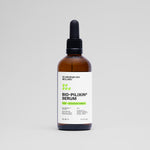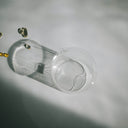Hair growth isn’t something you notice overnight, but tracking progress can help you see real changes over time.
Whether you're growing your hair out, treating hair loss, or monitoring results from a new treatment, knowing how to measure hair growth properly makes all the difference.
From simple at-home methods to high-tech professional tools, here’s how experts and individuals alike can track hair growth with accuracy.
Table of content
How does the hair growth cycle work?
Hair grows in cycles, moving through four stages: growth (anagen), transition (catagen), rest (telogen), and shedding (exogen). Most hair stays in the growth phase (anagen) for 2 to 7 years, depending on genetics, hormones, and overall health. The longer this phase lasts, the longer hair can grow.
The transition and resting phases are much shorter, lasting weeks or months. During this time, hair follicles shrink, growth slows, and eventually, shedding begins.
On average, people lose 50 to 100 hairs per day, which is completely normal. If shedding seems excessive or new growth is slow, factors like stress, poor diet, or hormonal imbalances could be at play.
Since hair doesn’t grow at the same rate for everyone, tracking progress helps set realistic expectations. Understanding these cycles makes it easier to notice changes and take steps to support healthy growth.
As your leading source for hair health information over the past 4 years, we never compromise on accuracy. When it comes to your health, you deserve information you can truly rely on - and earning your trust is our top priority.
Here's how Scandinavian Biolabs ensures every piece of content meets the highest standards of accuracy and integrity:
- Credentialed Experts: Our reviewers are actively practicing doctors and medical researchers
- Stringent Reviews: Content undergoes rigorous editing by subject specialists and review by a practicing doctor.
- Evidence-Based: We rely on well-established research from trusted scientific sources like peer-reviewed journals and health authorities.
- Full Transparency: Our editorial standards, writer credentials, reviewer credentials, correction process, and funding are all publicly documented.
- Independent Voice: While we do promote products, we operate in a vacuum to business operations. Our main goal is just an unwavering commitment to providing medically-sound guidance.
You can count on Scandinavian Biolabs to consistently deliver the trustworthy health information you deserve. Read our Editorial Standards.
Why measure hair growth?

Measuring hair growth helps track progress, identify potential hair loss, and evaluate whether treatments are working. Whether you're growing out a haircut, using hair loss medication, or trying a new supplement, regular measurements help you see if your efforts are paying off.
Hair growth isn’t always easy to notice day by day, but small changes add up over months. By tracking hair length, density, or thickness, you can spot patterns in your hair growth and adjust your routine if needed.
This is especially helpful for people dealing with thinning hair or regrowth after shedding.
For professionals like dermatologists and researchers, measuring hair growth provides a scientific way to assess hair health.
Tools like trichoscopy and phototrichograms offer precise data on hair density, thickness, and growth rate.
Whether you're doing this at home or with a specialist, keeping track of hair growth gives you a better understanding of how your hair is really doing.
Professional methods to measure hair growth
Professionals use advanced tools and techniques to measure hair growth with precision. These methods go beyond simply tracking length, helping to analyze hair density, thickness, and overall scalp health.
Digital trichoscopy (scalp imaging)
Trichoscopy is a high-resolution scalp imaging technique used by dermatologists to assess hair growth, density, and follicle health. It provides a magnified view of the scalp, helping experts detect early signs of hair thinning or scalp conditions.
- Identifies miniaturized (thinning) hair and follicle changes
- Helps monitor hair loss treatments over time
- Provides detailed insights into scalp conditions like dandruff or inflammation
This method is non-invasive and painless, making it a go-to choice for professionals diagnosing hair concerns or tracking progress with treatments.
Phototrichogram (hair mapping)
A phototrichogram is a scientific method used to map hair growth and shedding patterns. This technique involves shaving a small section of hair, then taking high-resolution photos over time to track how new hair emerges.
- Measures growth speed, density, and shedding rates
- Commonly used in clinical studies for hair growth treatments
- Provides an accurate view of how much hair is actively growing
This method is incredibly precise, making it useful for monitoring medications like minoxidil or finasteride. However, it’s typically performed in a dermatologist's office or research setting rather than at home.
Hair pull test & tug test
These simple but effective tests help identify excessive hair shedding and assess hair strength.
- Hair pull test: A small section of hair is gently pulled to see how many strands come loose. Losing more than 10–15 hairs suggests abnormal shedding.
- Tug test: A few strands are held near the root and pulled along their length. If hair breaks easily, it could indicate brittle or damaged strands.
These tests don’t measure hair growth directly, but they help doctors identify underlying hair health issues like telogen effluvium (temporary hair loss) or breakage due to damage.
Trichometer measurement
A trichometer is a handheld device that measures hair diameter and density, providing insight into hair thickness and miniaturization (thinning).
- Used to track hair thickness over time
- Helps diagnose androgenetic alopecia (pattern hair loss)
- Provides precise measurements for monitoring hair regrowth treatments
Since thinning hair often happens before noticeable bald spots appear, a trichometer can catch early signs of hair loss that might otherwise go unnoticed.
Hair weight measurement
Though not commonly used outside research, hair weight measurement involves collecting shed hair and weighing it to estimate growth and shedding rates.
- Provides a quantitative way to track shedding over time
- Often used in clinical studies on hair growth treatments
- Less practical for everyday use, but valuable for research
This method requires specialized equipment, so it’s mostly limited to lab settings. However, for those undergoing clinical trials, it can offer valuable insight into how well a treatment is working.
Microscopic hair shaft analysis
Microscopic analysis examines individual hair strands under high magnification, helping professionals assess structure, damage, and thickness.
- Detects weak spots, split ends, and irregularities in the hair shaft
- Helps diagnose hair disorders like trichorrhexis nodosa (brittle hair)
- Used to study the effects of hair care products or treatments
This technique is particularly useful for people dealing with fragile or damaged hair, as it provides a close-up look at the structural health of each strand.
At-home methods to track hair growth
You don’t need fancy equipment to keep an eye on your hair growth. Simple at-home methods can help you track progress over time and notice any changes in growth rate or hair health. Here are some of the most effective ways to measure hair growth at home.
Measuring tape method
Using a soft measuring tape is one of the easiest ways to track hair growth. It’s simple, inexpensive, and gives you a clear idea of how much your hair has grown over time.
- Start by selecting a consistent reference point on your head, like the center of your forehead or crown.
- Use a soft, flexible measuring tape and place it at the root of a strand of hair.
- Gently stretch the hair down and note the length.
- Repeat this process once a month for the most accurate tracking.
For the best results, measure your hair when it's dry and straightened, as wavy or curly hair can make it harder to get an accurate reading.
Time-lapse photography
Taking progress photos is a great visual way to track hair growth. Hair grows slowly, so seeing side-by-side comparisons over time can help you spot real changes.
- Take photos from the same angle, in the same lighting every few weeks.
- Use a plain background to avoid distractions.
- Try parting your hair the same way each time to make comparisons easier.
- Mark the date on each photo so you can track your progress.
This method works especially well if you’re using a new hair treatment and want to see if it’s making a difference.
Marking hair growth on a scalp chart
A scalp chart is a simple way to document where hair is growing and how much progress you’re making.
- Use a diagram of a head (you can draw one or print a template).
- Mark the areas where you’re noticing new growth or thinning.
- Update the chart monthly to keep track of progress.
This method is especially helpful for people recovering from hair loss or tracking patchy regrowth in specific areas.
Shed hair analysis
Hair shedding is normal, but counting how much hair you lose can help you notice any unusual changes.
- Collect shed hair from your brush, shower drain, or pillow over a few days.
- If you notice excessive shedding (more than 100 hairs a day), it might be time to investigate possible causes.
- Keep a small journal to track changes—sudden increases in shedding could signal stress, diet changes, or health issues.
This method helps you understand your hair growth cycle and detect early signs of thinning.
Factors that can affect hair growth measurements
Hair growth doesn’t always follow a perfect pattern. Many factors can influence how fast or slow your hair appears to grow, which can make tracking a little tricky.
- Hair texture and curl pattern – Straight hair appears longer than curly or coily hair, even if the actual growth rate is the same. Measuring stretched hair gives a more accurate result.
- Seasonal changes – Some people notice faster hair growth in the summer due to increased blood circulation and sun exposure, while winter can slow things down.
- Hormonal shifts – Pregnancy, menopause, thyroid issues, and hormonal imbalances can speed up or slow down hair growth.
- Diet and nutrition – Hair thrives on nutrients like protein, iron, and vitamins. A poor diet can lead to slower growth or more shedding.
- Hair damage and breakage – Hair that breaks easily due to heat styling, chemical treatments, or rough brushing may seem like it’s not growing, even if new growth is happening at the roots.
- Medications and treatments – Some medications (like birth control, antidepressants, or chemotherapy) can affect hair growth, while treatments like minoxidil and finasteride may speed it up.
- Genetics – Everyone has a natural growth phase length, which determines how long their hair can grow before shedding and restarting the cycle.
Keeping these factors in mind will help you track growth more realistically and understand what’s influencing your results.
When to seek professional hair growth assessment
If your hair isn’t growing as expected, or you’re noticing excessive shedding, thinning, or bald patches, it might be time to see a professional.
Consider a dermatologist or trichologist if:
-
You’re losing more than 100 hairs per day consistently.
-
You have bald spots, excessive scalp itching, or redness.
-
Hair growth is significantly slower than usual or has stopped entirely.
-
Your hair is breaking easily despite using gentle hair care methods.
-
There’s a family history of hair loss, and you’re noticing early signs of thinning.
A specialist can pinpoint the cause of hair loss, suggest treatments, and recommend professional methods to measure and track your hair growth more accurately.
A holistic approach to your overall hair health

Measuring hair growth is one thing, but supporting healthy hair from the inside out is just as important. A well-rounded approach includes good nutrition, gentle hair care, and, for some, products designed to help maintain hair density and reduce shedding.
One option people explore is Bio-Pilixin® Activation Serum. Developed by experts, it contains plant growth factors designed to nurture hair follicles and support hair regrowth.
The formula is drug-free and safe for daily use, making it a choice for those looking for a simple addition to their routine. A clinical trial with 30 participants found that after 150 days, 93% experienced a reduction in hair loss, and 73% saw an increase in hair density.
While results vary, some users notice less shedding in as little as 45 days.
The serum includes ingredients inspired by nature, such as Capilia Longa®, Niacinamide, and Vanillyl Butyl Ether.
Capilia Longa® has been studied for its potential effects on hair density, while Niacinamide supports keratin production, which helps strengthen hair.
Vanillyl Butyl Ether creates a gentle warming sensation, which may improve blood flow to the scalp. Each ingredient has been selected based on scientific research and evaluated by third-party laboratories.
With a 150-day money-back guarantee, it’s an option worth considering for those tracking their hair growth journey.
Conclusion
Tracking hair growth helps you see real progress, whether you're growing your hair out, recovering from hair loss, or testing a new treatment.
Simple at-home methods like measuring tape, photos, and scalp charts can give you a good idea of how your hair is changing over time.
For a more precise approach, professionals use advanced tools like trichoscopy, phototrichograms, and trichometers to measure hair density, growth rates, and overall scalp health.
Hair growth isn’t just about length—it’s about keeping your scalp and strands in the best possible shape.
Factors like diet, hormones, and hair care habits all play a role, and for those looking to support their hair, products like Bio-Pilixin® Activation Serum offer another piece of the puzzle.
Whether you go the DIY route or seek professional advice, keeping track of your hair’s progress can help you make informed choices and set realistic expectations.
References:
- https://pubmed.ncbi.nlm.nih.gov/1911294/
- https://www.jaadinternational.org/article/S2666-3287(24)00022-1/fulltext
- https://www.researchgate.net/publication/10905664_Methods_of_evaluating_hair_growth
- https://pubmed.ncbi.nlm.nih.gov/38545491/
- https://www.sciencedirect.com/science/article/pii/S2949877523000035





